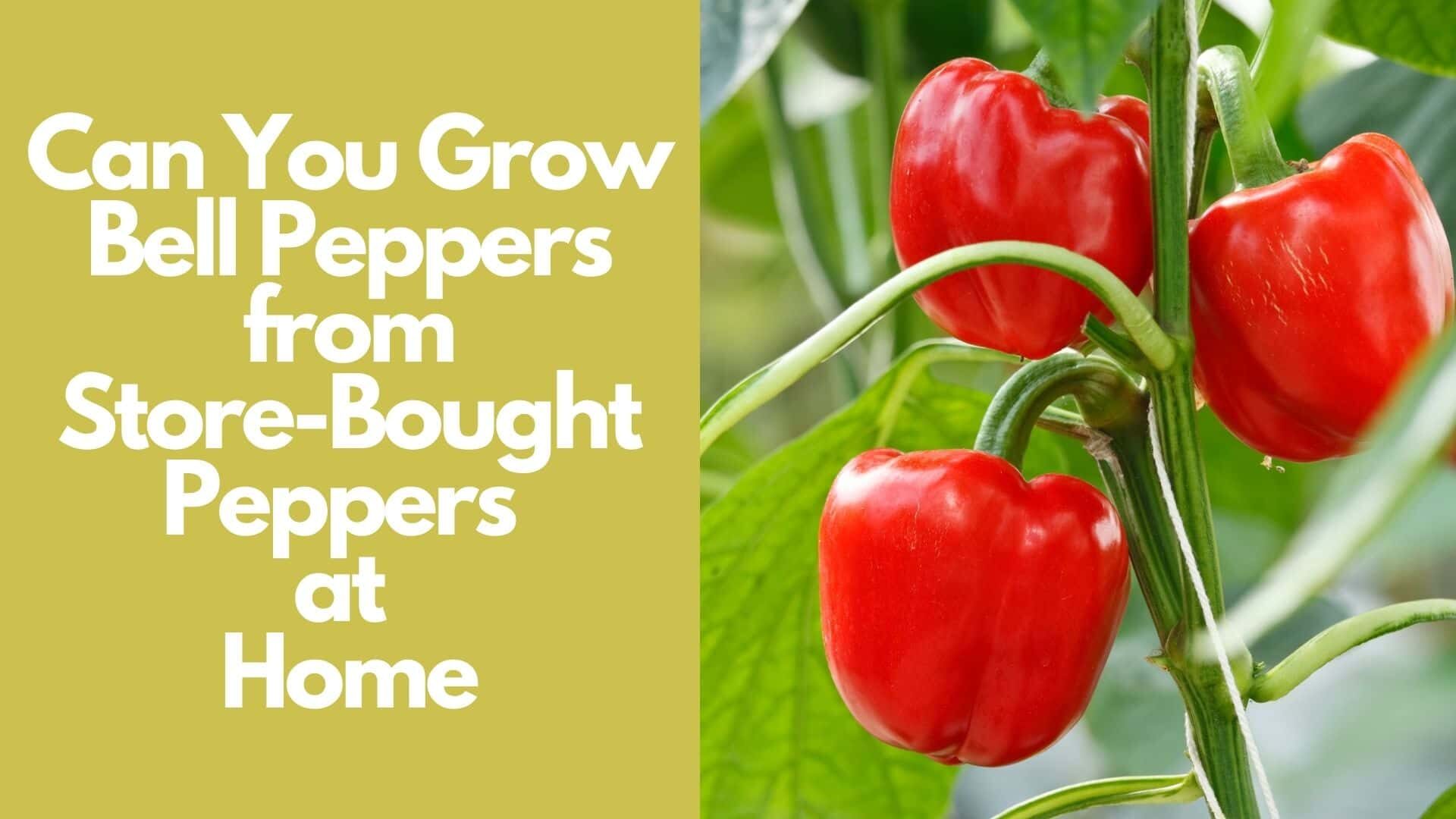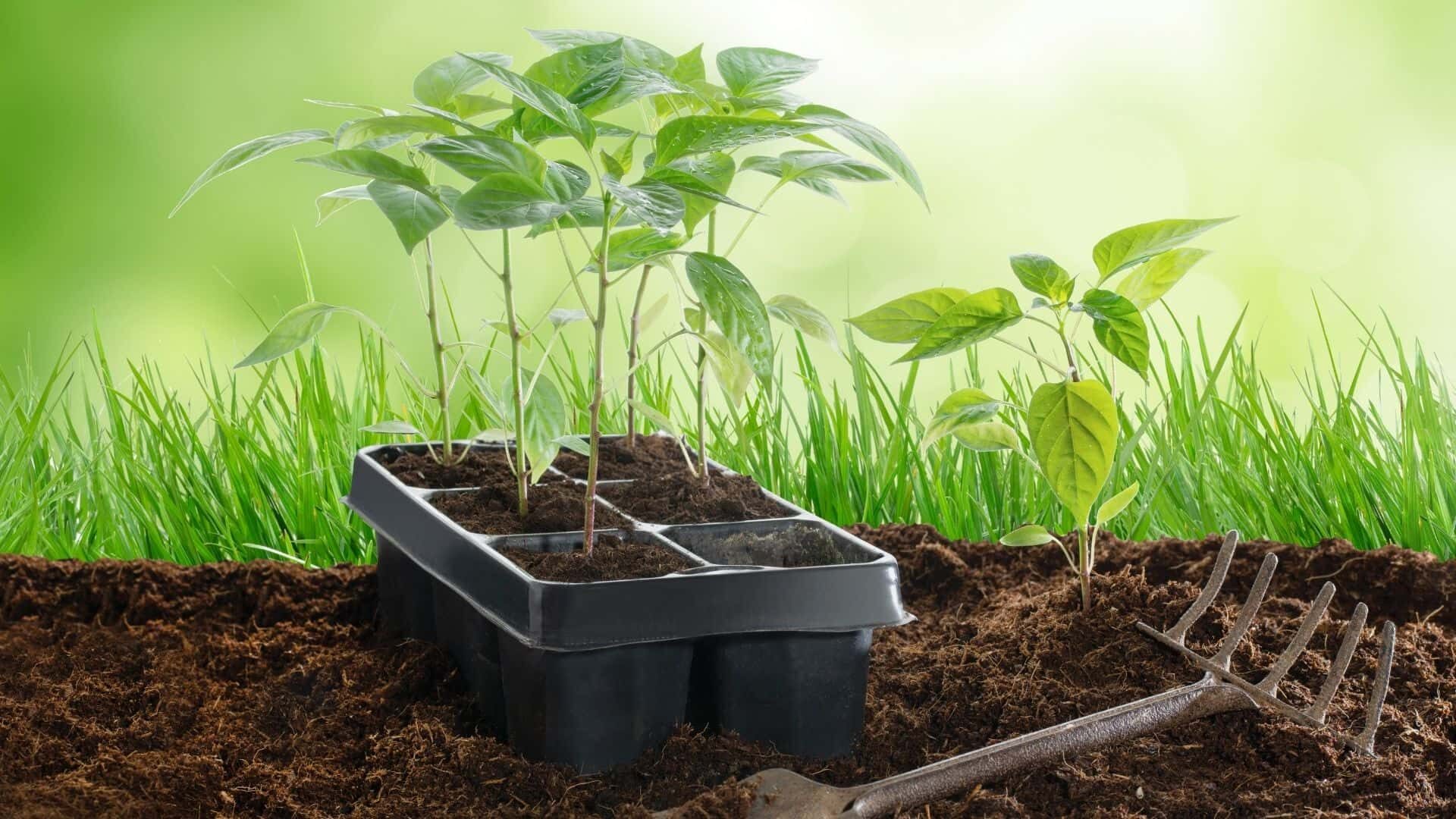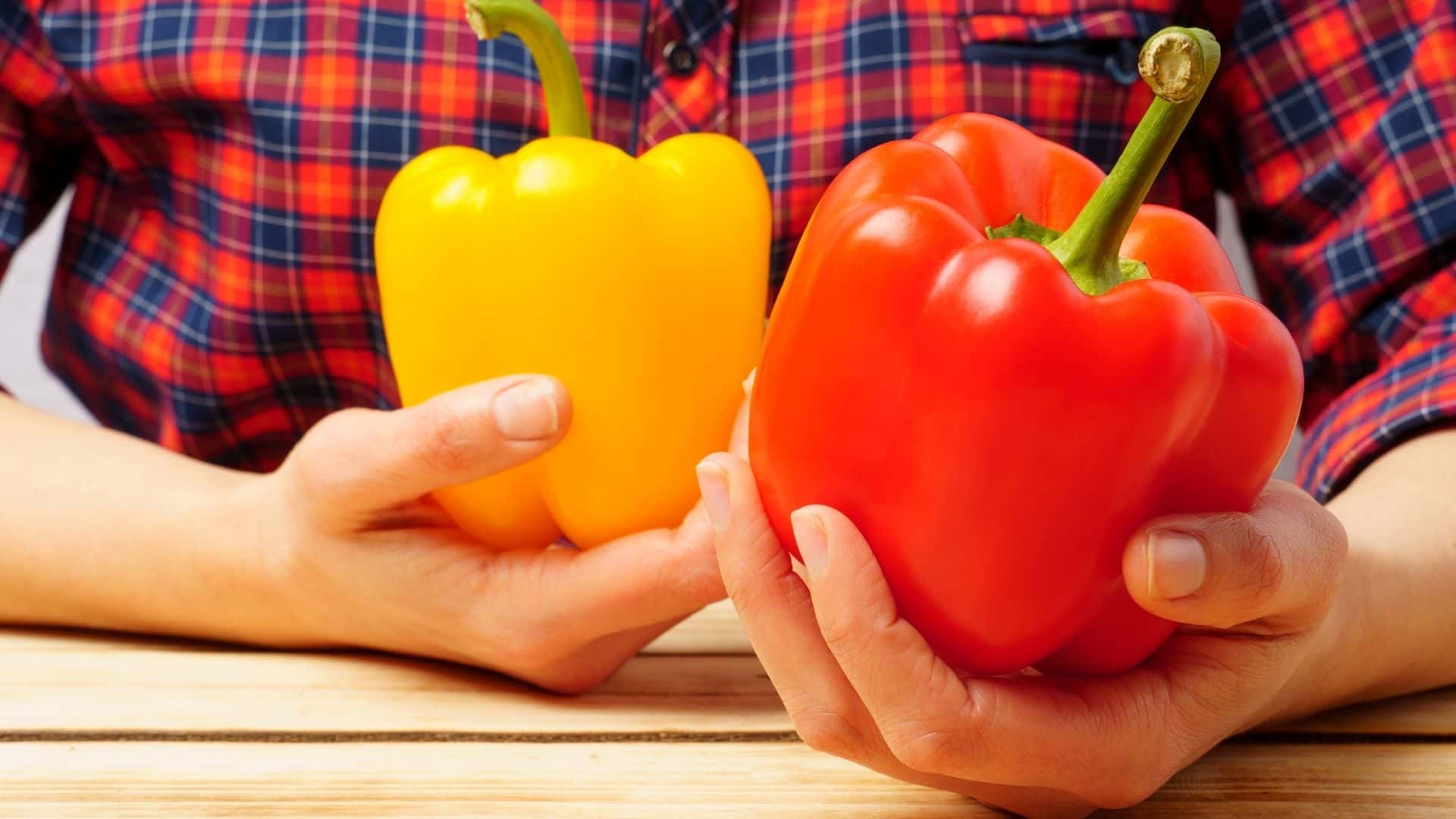One of the fruits that we all consider vegetables is the bell pepper. Regardless of how you choose to use it, the vibrant colors and lush foliage will add a splash of color to your outdoor space. Color of bell peppers changes as they age on the plant, going from green to yellow, orange, and red. In addition to the more common green, orange, yellow, and red bell peppers, there are also white, brown, and purple variants. On the plant, all unripe bell peppers are green.
Every recipe can benefit from the addition of bell peppers. Whether you choose to eat them raw in salad dressings or cook them in a variety of cuisines, they’re a versatile ingredient. There are many ways to incorporate bell peppers into your diet, from pizza and soups to burgers, pasta, and sauces.
Bell peppers are easy to grow in your own backyard. It’s a better option than purchasing at a market. When it comes to growing bell peppers from store-bought bell peppers, most gardeners aren’t sure if it’s possible. But actually, you can grow healthy bell peppers from store-bought bell peppers. By reading this guide, you will be able to know Can you grow bell peppers from store-bought peppers at home?.

For the most part, bell peppers from store-bought peppers are grown for personal consumption rather than for commercial purposes. Although these do not match with the color, taste, yield, and fruit size of their parent fruit, you can take a better harvest from them.
What do you need to grow bell peppers from store-bought peppers?
For homegrown bell peppers from store-bought peppers, all you’ll need is a few simple supplies.
- Store-bought bell Pepper
- Paper towel
- Clean knife
- Soil
- Container
- Water
How to grow bell peppers from store-bought peppers?
Here are a few guidelines for successfully growing bell peppers from store-bought peppers.
1. Choose the right bell pepper.
You should elect mature or ripe bell pepper for growing. Fully ripe bell peppers, which are normally just past the desirable eating stage, are the only source of viable seed for pepper plants. When the skins begin to wrinkle, it is good to grow.
If you buy pepper in the supermarket, it may be a hybrid. This indicates that they may be created by two distinct species. Hybrid peppers are perfectly fine, but if the seeds are planted, you won’t get the pepper you have because the seed might select the dominant gene of a particular kind. As a result, you may receive a plant that is different from the one you purchased.
2. Prepare the seeds.
To remove the pepper’s core, just cut around the stem with a clean knife and gently twist it out. Most of the seeds are still connected to the core when you remove them.
The seeds can now be carefully brushed from the core onto a paper towel or a tray. In a single layer, spread the seeds out evenly and leave them somewhere for a few days or leave them out in the sun for an hour until they are completely dry. Your bell peppers lose their viability if you leave the seeds out in the sun for too long. You can also put them under a ceiling fan or a shade to dry.
3. Select a right container.
A germination tray, plastic bag, pot, or any other container can be used to sow seeds. In order to harvest healthy plants, the container must have drainage holes. Drill a few holes on the bottom of the container if it does not already have drainage holes. You can also use a heated screwdriver to make holes.
7. Fill the container with soil.
Organic matter-enriched sandy loamy soil is ideal for growing store-bought bell peppers. With these features, you can either buy a potting mix or purchase each of the components separately and make your own. Then, fill your pots about 3/4 with soil.
8. Sow seeds in the container.
In order to start a bell pepper plant, you must first start the seeds inside. Seeds can also sow outdoors, but the temperature and other conditions must be just right. Growing indoors is relatively simple.
Pepper plants should be started 6 to 8 weeks prior to the last spring frost date in most locations. Water to the surface of the soil and sow the pepper seeds right now. Place a single layer of seeds on top of the soil, spacing them out evenly.
It is easy to sow handful seeds into the soil but it will be difficult to separate the plants after planting. They’ll consume all the nutrients far too quickly if you don’t separate them. Finally, add a thin layer of soil on top of the seeds. Water lightly to keep the soil moist. Avoid overwatering the seeds.
9. Place container in the right place.
Place them at a temperature between 80-85 ⁰F (22-29⁰C). The germination time can be shortened by the right conditions. So, keep the container in a bright window or another warm spot. Watch for sprouts within the 2 weeks after planting your bell peppers.
10. Transplant seedlings.

Seedlings should be transplanted to larger containers or garden soil once they’ve grown their first three leaves. Germination typically takes two weeks. Depending on the variety, this may change.
If you’re planting in containers, you’ll need to harden off your seedlings. Hardening off is an excellent approach to familiarize plants with the outdoors. Increase the amount of time you spend outside over time. After familiarizing with the outdoors, you can leave them outdoors throughout the day. If not, the seedlings may be shocked and die. Make careful to give them plenty of watering.
As for growing them in your garden, be certain that the soil temperature is 70-75⁰F before you start. It is also possible to transplant these seedlings in the garden after frost has passed.
Adding black plastic mulch to your garden soil will assist keep the soil warm if it isn’t meeting the temperature requirements.
If you are gardening in a garden, place the bell peppers 12-18 inches apart on raised beds. When the topsoil is dry, water it. Avoid overwatering your garden soil, as bell peppers do not thrive in wet conditions.
How to care for grown bell peppers?
Here are basic caring tips that should follow when growing store-bought bell peppers at home. If you will follow these, you can grow and harvest healthy bell peppers in your own garden.
1. Watering
Water your bell peppers deeply approximately 1 or 2 inches per week. That can differ depending on weather conditions. Despite the fact that bell peppers prefer warm weather, they will not thrive in extremely hot conditions, thus gardeners in hot climates should water their plants twice daily.
Overwatering can suffocate the roots and produce blossom end rot. So, it is important to water your bell pepper plants correctly.
2. Exposure to the sun
Bell peppers need full exposure to at least 6 to 8 hours of daily sunlight to grow to their largest and healthiest potential. Keep them in a sunny area in your garden. Consider using shade cloth or nearby plants if you live in a region that is prone to high temperatures and excessive sunlight.
3. Mulching
If you want to keep your ground soil warm, use black plastic mulch. Bell peppers also benefit from grass clippings, which cover weeds and protect the root systems of the bell pepper plants.
4. Check for pests and diseases
Careless maintenance can lead to a variety of pests and diseases. Keep an eye on the bell pepper plant every day. Then you’ll be able to assess the health of your plant. Take good care of the plants. Water, light, and fertilizing are all necessary to the plant’s well-being and its ability to produce an abundance of healthful fruits.
It’s important to identify the diseases and apply the proper fertilizer to your plant if it appears to be infected. Remember to remove any plant parts that are infected with the disease. To keep pests at bay, use organic insecticides and make frequent visits to your plant.
There are some pests and diseases that affect bell peppers such as,
How to prevent from damping-off?
The suppression of seedling growth is caused by this fungal disease. The fungi destroy the root systems of young plants as well as illness can observe in adult bell pepper plants.
When the ground temperature and watering aren’t ideal, you’ll have this issue.
How to prevent from blossom’s end rot?
You’ll notice brown or black lesions on the flower ends and unripe fruits of bell peppers if they don’t get enough calcium and water. This problem is more likely to occur if the soil is overly wet and poorly drained.
So, be sure to use containers that have drainage holes and never overwater. Adding lime soil and increasing the calcium content of the soil can help improve the soil’s pH.
How to prevent from gray mold disease?
When the humidity is above 85% and the air circulation is inadequate, a fungus commonly attacks bell peppers in greenhouses. Consider about temperature and humidity of the environment.
How to prevent from sunscald?
Fruits and foliage alike can be damaged by sunscald. Cracking may be visible on the fruit’s surface. Overexposure to sunshine is to blame.
You can move bell pepper plants to another location to prevent this disease.
5. Fertilizing
Before planting seedlings in your garden, use compost as organic fertilizer. Then, after the first harvest, repeat the process.
Avoid over-fertilizing your bell peppers with heavy nitrogen fertilizers because this will favor the growth of leaves rather than fruits or blooms.
Check to see if your soil is rich in calcium and phosphate, which are essential for peppers to thrive.
6. Weeding
To ensure that your garden flourishes and grows healthy and lush, regular weeding is a need. . Weeds can be controlled by covering your garden in black plastic.
However, because the roots of bell peppers are so delicate, exercise extreme caution when removing undesired weeds from the area. So, be careful when removing weeds
When to harvest bell peppers?
Depending on the type of pepper you want, it can take anywhere from 60 to 90 days for the peppers to mature. Leaving a green pepper to ripen on the plant will eventually transform it into a yellow, orange, and finally, red pepper, which is the tastiest and most flavorful.
Pick the fruits as soon as they reach their full size and color when the plants start producing them. For plants, regular picking encourages the growth of flowers and fruits.
To harvest a bell pepper from the plant, use a clean sharp knife or scissors. The plant can be damaged if you tear it with your hands.
Where to store bell peppers?
You may use fresh bell peppers in any meal. The longer you plan to keep them, the better it is to store them in the refrigerator. However, while storing fruit in the fridge, avoid washing it to prevent it from going bad too quickly.
If you do decide to wash them, make sure to pat them dry completely before putting them away. In the refrigerator, raw peppers can be kept for up to 2 weeks and cook peppers for 3 to 5 days.
How to preserve seeds of store-bought bell pepper for future use?
If you aren’t planting the seeds right away, you’ll need to store them properly to ensure their viability. When stored correctly, bell pepper seeds can keep for at least two years. In a paper envelope or in a glass jar, you can keep the seeds safe. Jars should pack with silica gel to help dry out any moisture that may be trapped inside. Seeds for bell peppers should be stored in a dark, cold place with the variety and harvest year clearly labeled.
What are the advantages of growing bell peppers from store-bought peppers?
There are a lot of advantages of growing store-brought bell peppers in your home garden. Here are a few of them.
1. Able to taste fresh bell peppers
Even as soon as harvested, it is possible to taste the flavor of fresh bell peppers. There is no need for transportation, and the food isn’t sitting on the shelf for a long period because it’s picked right when you need it.
2. Improve your health
As part of an overall healthy diet, fresh bell peppers are indispensable. Bell peppers are an excellent source of valuable nutrition.
Among their many health benefits are their high concentrations of vitamins C, A, B6, and B9, all of which may be found in bell peppers. In addition, it aids in eye health, anemia prevention, and weight management. When you grow bell peppers at own garden, you know what it is used for. So, Fresh homegrown bell peppers help to improve your health.
3. Take new experience
This will be a new experience for everyone. If you grow grocery-store bell peppers successfully from planting to harvest, you are great. You can try it for other fruits and vegetables.
4. Save money
Bell peppers might help you save money on your monthly grocery expenditure. The more successful you are, the more likely you are to repeat this process. So, you can also earn money by selling them.
5. Reduce Waste
Preserving or using up bell peppers before it goes bad is also a good idea. You may teach your children about the significance of using what the planet has given you to its maximum potential and avoiding waste by growing fruit and vegetables in your own garden.
What are the disadvantages of growing store-bought bell peppers?
Planting bell peppers are best done using mature peppers from the grocery store. Ripe and mature bell peppers aren’t always available, and that’s understandable. Your store-bought bell peppers can also die if you don’t follow the proper planting and care instructions.
Watch How to solve bell pepper problems | Video
Top 5 FAQs & answers related to Can you grow bell peppers from store-bought peppers at home
Before sowing, should soak pepper seeds?
Bell pepper seeds should not be soaked in water or kept cool to assist germination, unlike some other plants’ seeds.
Which companion plants can grow with bell peppers?
Bell peppers work well with corn, cucumbers, carrots, basil, and parsley. But, cabbage and broccoli do not grow with bell peppers.
How many fruits per bell pepper plant?
This does not include the smaller peppers you’ll harvest earlier in the season. If the plant is healthy, you’ll get more fruits from it. This is mostly due to factors such as the quality and consistency of watering, pest or disease damage, etc.
Why doesn’t a pepper plant bear fruit?
It can be caused by inconsistent watering, temperature, and careless maintaining. Don’t provide too much nitrogen fertilizer because it will help to improve the foliage of plants. So, to bear fruit, peppers require an increase in phosphate and potassium.
Do bell peppers need a trellis to grow?
In order to produce bell peppers in your garden, you don’t need to stake them but they have benefits. Pepper staking not only keeps plants upright but also reduces sunscald on fruits and keeps them off the ground, where they are vulnerable to pests.
Conclusion
By reading this guide, I hope you got the full idea of Can You Grow Bell Peppers from Store-Bought Peppers at Home?.
Please share this Can You Grow Bell Peppers from Store-Bought Peppers at Home? with your friends and do a comment below about your feedback.
We will meet you on next article.
Until you can read, How to Use Epsom Salt for Cucumbers: Guide with Tips
